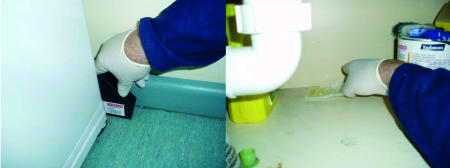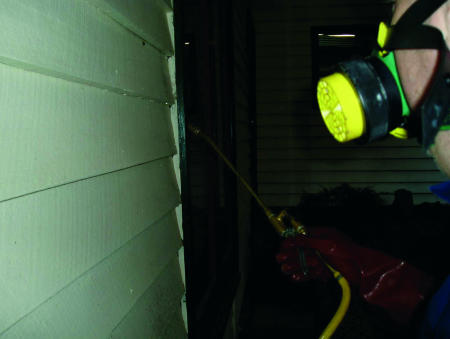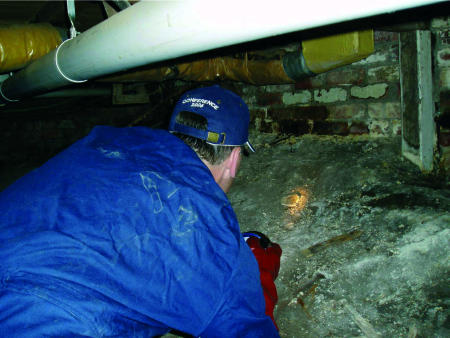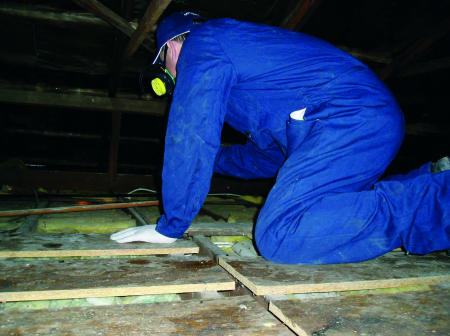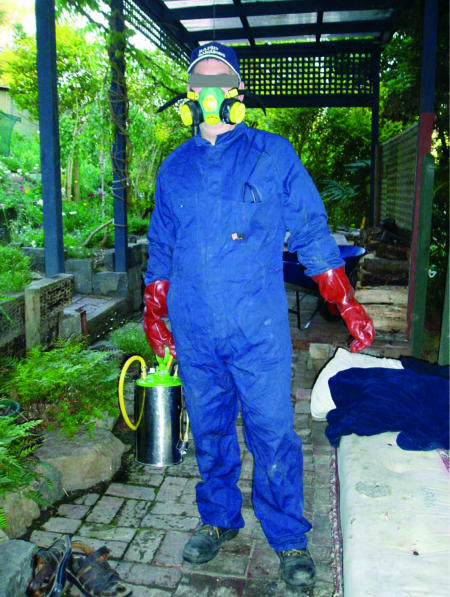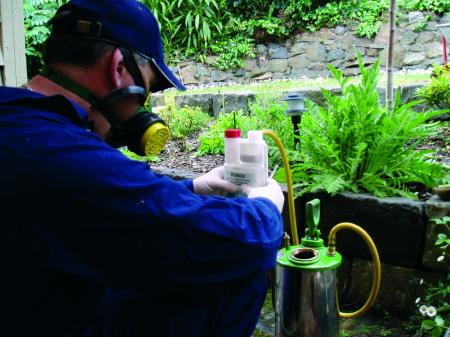Short abstract
Occupational tasks of domestic and commercial pest control operators in Australia
Domestic and commercial pest control is the management of undesirable animals that intrude on human activities in commercial or residential settings.1 Although the spectrum of control measures available in the modern pest control industry now includes non‐chemical methods, especially for larger animal pests, the application of chemical pesticides remains a necessary tool for pest control operators. Over the past 50 years, pesticide production and usage has increased dramatically worldwide, revolutionising the management of pests for the protection of public health and property.2,3 In the Australian context, pest management is an important activity; termites alone cause tens of millions of dollars damage in Australia every year.4 Occupational exposure to pesticides is an important issue among the pest control workforce,5 and the potential exists for both acute and long‐term human health consequences.4
This paper summarises the occupational tasks of Australian domestic and commercial pest control operators, the spectrum of occupational hazards presented by their work and general measures for the control of these hazards. This paper describes the situation in the Australian pest control industry, and, although the principles will be applicable to urban pest control workers in other countries also, there may be differences associated with environment and culture, such as differences in pest species, pesticides used, application methods, educational requirements, laws, regulations and protective clothing.
Tasks of the job
Pest control operators deal with a variety of pest animals in food‐handling premises, industrial sites and private homes, as well as in human service locations, such as schools and hospitals. Food‐handling premises are particularly attractive to a variety of pests, and control of those pests safeguards public health by reducing the risk of microbial contamination of foods. Table 1 shows the main types of pest relevant to urban pest control operators.
Table 1 Animal pests relevant to the pest control industry.
| Pest type | Examples |
|---|---|
| Food‐premises pests | Cockroaches, rodents |
| Colonial insects | Wasps, bees, ants |
| Disease vectors | Mosquitoes |
| Structural pests | Borers, termites |
| Spiders | Poisonous and non‐poisonous spider species |
| Animal/human parasite insects | Fleas, mites |
| Large mammals | Possums |
| Urban birds | Pigeons, starlings |
In Australia, pest control operators are mainly employed by small companies (with <10 operators) specialising in pest control work. Operators attend problem sites where they diagnose the problem, plan control strategies and then undertake the control. Licensing of pest control operators is undertaken by state governments and operators learn by on‐the‐job training, with no formal qualifications required. However, high staff turnover, the large number of small businesses in the industry and the fact that this work is often performed often in isolation at dispersed sites have traditionally made the effectiveness of training and enforcement of occupational health and safety regulations problematic, and compliance is often poor.5
The application of pesticides is a frequent activity among pest control operators, and there are four main application methods:
(a) space spraying for flying insects;
(b) surface treatment for crawling insects;
(c) fumigation for insect pests inside materials;
(d) baiting for rodents and certain insects.
Space spraying and surface treatments are the most common application methods. Pesticides most commonly used for space spraying are quick‐knockdown, non‐residual types, including a number of pyrethrins. Organophosphates, including dichlorvos, are sometimes used.1 The application process involves distribution of a small amount of liquid insecticide into a large space, such as the inside of a house or a warehouse, as small droplets blown into the air to eliminate flying insects on contact.
Surface treatments usually employ more persistent pesticides and rely on the residue that remains on the surface. Surface treatments include dusting, which may involve a small hand dispenser or larger pressurised equipment, and surface spraying, which may require the use of a small‐scale operator‐carried spray unit and reservoir or a larger vehicle‐mounted unit. There is a variety of pesticide products that are applied as surface treatments, including certain pyrethrins, organophosphates, carbamates, and inorganic insecticides such as boric acid and arsenic trioxide.1
Fumigation is the treatment of a sealed space with a gas. In Australia, fumigation is an uncommon method of insecticide delivery, but it remains the method of choice for some stored food‐product infestations and wood‐boring insects. It is performed in a sealed space, with the operator on the outside. Items may be placed in a fumigation chamber, or a whole building or part of a building may be made as airtight as possible and the gas released from within. Fumigation gases used include carbon disulphide, chloropicrin, ethylene oxide and methyl bromide1; however, the use of methyl bromide is being phased out in Australia for environmental reasons.6 Because of the hazardous nature of many fumigant gases and the possibility of fugitive emissions, specific licensing or training is required in many Australian states.1
Baiting for rodents and certain insects involves distribution of pellets, gels, powders, wax blocks or foodstuffs such as cereals, bread, meat or vegetable matter, impregnated with pesticide product (fig 1). Because of their inherent human toxicity, rodenticides formerly used in baiting, including arsenic trioxide, sodium fluroacetate (1080) and strychnine, have been largely replaced by anticoagulant rodenticides such as warfarin.1
Figure 1 Setting baits—enclosed bait station (left) and gel bait (right).
Various deterrent measures are used by pest control operators for larger animals, including possums, birds and bats. In Australia, possums represent a major domestic nuisance when they nest in house roof spaces, but species protection law now prohibits extermination. Similarly, it is not considered appropriate to poison urban birds. Removal of possums or other large animals is a task limited to a specialised section of the pest control workforce. Trapping and release of animals and subsequent closure of access points is the usual control method, but temporary installation of one‐way exits in roof‐space access points is now more common. The animals exit according to their usual diurnal patterns, unable to re‐enter; the exits are subsequently closed off permanently. A variety of structural deterrents may also be applied to buildings to prevent access by large mammal and bird pests.
Hazards of the job and in the workplace
The main hazards of pest control are summarised in table 2. Although pest control operators may be involved in a variety of activities to prevent pest infestation and the physical removal of certain kinds of pest animals, the central activities of the pest control workforce involve extermination of invertebrate and rodent pests using pesticides.
Table 2 Workplace hazards for pest control operators.
| Chemical hazards1 | Physical/environmental hazards | Biological hazards |
|---|---|---|
| Organophosphates (eg, chlorpyrofos, diazinon, dichlorvos, fenitrothion, fenthion and maldison) | Confined spaces | Bites and scratches |
| Carbamates (eg, carbaryl, bendiocarb, propoxur and methomyl) | Constrained spaces | Stings |
| Synthetic pyrethroids (eg, bioresmethrin, d‐phenothrin, tetramethrin and permethrin) | Falls from heights | Allergens |
| Fumigant gases (eg, hydrogen cyanide, methyl bromide and ethylene oxide) | “Building‐related” exposures (including lead, asbestos, electrical wiring, etc) |
With the phasing out of organochlorine pesticides in the 1980s in many countries, primarily driven by environmental concerns, there has been a greater use of carbamates and synthetic pyrethroid pesticides and certain organophosphates.7,8,9 The effects of exposure to anticholinesterase pesticides are well documented and may include acute neurological symptoms, usually a consequence of high‐dose poisoning, and delayed chronic neurological effects.9,10 The carbamates, organophosphates and pyrethrins used by pest control operators in Australia today are generally considered to be of moderate to low human toxicity.11 Dermal exposure to α‐cyano pyrethrins can cause temporary contact paraesthesia, apparently without lasting effects.12
With the exception of ready‐to‐use products, liquid pesticide products are bought and stored as concentrates, and diluted (mixed) and loaded into application devices on‐site before actual application. Owing to the concentrated nature of the products and risk of spillage, this phase of the operator's activities presents the highest risk of significant exposure.13
In the case of any applications where the operator dispenses the product by hand‐held nozzle (fig 2), there is potential for significant operator exposure because of the proximity of the operator to the application and because this is often done in a confined space. Where the pesticide is pumped into a space remotely, the potential for operator exposure is lower; however, precautions are still necessary if the operator needs to re‐enter the space after application. Operators should be guided by the pesticide manufacturer's recommendations regarding re‐entry times.
Figure 2 Applying pesticide by spraying.
Baits in solid or pelletised forms and ready‐to‐use bait packs (throw packs) should pose minimal operator risk. Liquid, powdered and gel baits pose greater risk of exposure if spillage occurs, and accidental human ingestion is possible if hygiene is poor.
Pest control operators are visiting workers in environments over which they typically have very limited control. They also often need to access parts of buildings not intended for regular human access, including roof spaces and under‐floor areas (figs 3 and 4). These workplaces pose a number of inherent hazards. For example, constrained spaces can pose ergonomic and musculoskeletal problems, and such areas may also pose confined space problems, because of inadequate ventilation. Some areas that pest control operators may access are elevated, including roof spaces and roof tops, and offer the potential for falls from ladders, access platforms, scaffolding or through ceilings.
Figure 3 Accessing under‐floor space.
Figure 4 Accessing roof space.
Other building‐related risks to pest control operators include possible exposure to asbestos, lead, and other chemical and biological hazards within buildings. Old wiring, particularly if gnawed by rodents, poses an additional risk of electrocution to operators accessing roof space and under‐floor spaces. Carrying heavy or awkward equipment from vehicles into buildings also poses potential for musculoskeletal problems, and operators driving between jobs are also at risk of occupational motor vehicle accidents.14 Operators may also incur wounds from structural elements in building spaces not intended for regular human access.
Being bitten or stung by the pest animal is another important hazard. In particular, operators removing large animals may be bitten and/or scratched in the process of animal handling. Operators may also be bitten by rodents when accessing infested areas. Animal bites, scratches and other wounds also carry a risk of wound infection.
Stings by wasps, bees and other stinging insects are usually of minor consequence, unless the worker develops an allergic reaction, which can result in anaphylaxis. The bites of poisonous spiders also pose a risk of death in Australia, especially the Red‐back (Latrodectus sp) and Funnel‐web (Atrax sp and Hadronyche sp) spiders.
Finally, access to animal‐infested areas of buildings may also expose operators to animal excrement dusts and other animal‐related allergens. Fungal spores and other allergens may also be present in significant quantities in areas accessed by pest control operators, especially in damp and poorly ventilated building spaces.
Measures to protect workers
Effective protection of these workers should be based on a multilayered approach, with responsibility taken at several different levels. Protective measures can be implemented at the level of regulatory bodies and government, others at the industry body level, company level or at the level of the individual worker. Pesticide manufacturers also have a role in contributing to the protection of the health of pest control operators through product‐safety measures. Most of the protective measures outlined below have components that must be taken up at several levels to be effective.
Protective clothing and hygiene measures
Universal precautions for pesticide use should include general covering of the body surface with sturdy cotton clothing including long sleeves and long trousers, washable boots, gloves and washable hat (fig 5).
Gloves should be of an appropriate waterproof kind, never fabric. The break‐through times of gloves used should be known and gloves should be changed at the recommended intervals.
When mixing pesticides, the thickest available gloves with the longest break‐through times are recommended, together with a full‐face shield. A rubber/plastic apron should be worn if spills are possible.
When spraying, a close‐fitting hat is necessary to protect the highly vascularised scalp area, and a full‐face shield or goggles should be worn to protect the eyes, especially when spraying overhead or if spray drift is possible.
Operators should keep their protective clothing on while cleaning application equipment at the end of each job.
After each pesticide application job and after clean‐up is complete, operators should remove protective clothing and wash hands on‐site and shower as soon as possible to prevent “take‐away” pesticide exposure.5 This usually means having a container of water on their vehicle.
All clothing should be laundered at the end of each shift, and pre‐wash soaking for 24 h in a household laundry soaking product (sodium percarbonate‐based)i is advisable to minimise residues.15
When handling baits, gloves must be worn and baits should be labelled when in place (fig 1).
Figure 5 Pest control operator wearing recommended clothing and personal protective equipment.
Respiratory protection
In most circumstances, a half‐face cartridge respirator is adequate for pesticide mixing and spraying tasks (fig 5), but a full‐face respirator is required for fumigation.
Pesticide product‐related measures
Low spill‐risk packaging—for example, inbuilt metred dosing systems and smaller packages—reduces spill risk when mixing and loading the product (fig 6).
Lower concentration or prediluted, ready‐to‐use liquid pesticide products reduce or eliminate the operator's exposure to concentrates.
Ready‐to‐use bait products—for example, throw packs—also reduce exposure.
Substitution of lower toxicity pesticides whenever possible—for example, anticoagulant rodenticides instead of strychnine and other high‐toxicity products used previously.
Precautions are also necessary for storage and transport of pesticide products, and the use of suitable packaging, attention to re‐closure of packaging and care following spillage are paramount.
Disposal or recycling of used pesticide containers should also be done with care and in accordance with the manufacturer's recommendations where applicable.
Figure 6 Diluting pesticide for use using concentrate in low‐spill risk packaging.
Physical hazard‐related measures
Ergonomic and musculoskeletal risks associated with accessing constrained spaces can be reduced by careful planning and by using appropriate equipment.
Operator training to recognise and assess structural hazards before entering crawl spaces and other possibly hazardous building spaces.
Ideally, heavy or awkward equipment should either be vehicle mounted or be designed with wheels or other devices to facilitate movement without injury risk to the operator.
Biological hazard‐related measures
Tetanus vaccination should be encouraged and any wounds correctly disinfected and dressed as soon as possible.
Operators with known atopic sensitisation to a particular insect type should not be deployed on jobs involving that insect.
In the event of a bite from a venomous animal, operators should be provided with means to contact local emergency medical services—for example, by carrying a mobile telephone—and operator training should include basic first aid for venomous bites.
Worker training and licensing
Operator training that is effective and distributed across the workforce is necessary to educate operators and employers about hazards, protective measures and regulatory obligations.
Training should be tailored to the needs of the local workforce.
Licensing should be linked to training. Licensing and training should be done by a regulatory authority and inspectorate with power to revoke licenses and enforce regulations and standards.
Conclusion
Pest control operators can be exposed to a wide range of chemical, physical and biological hazards in their work, and these hazards may be different for each new site of work. Strict adherence to occupational health and safety requirements is poor in many parts of the pest control industry, and this is typical of small and owner‐operated businesses, which operate at sites remote from their central base.5 The problems of non‐compliance with safety recommendations in this industry are especially problematic, given the wide range of chemical, biological and physical hazards to which operators are exposed, and their potentially serious health and injury consequences.
Protection of workers' health requires safe behaviours by individual operators, including hygiene and primary hazard‐reduction measures at the job site, and it is necessary that employers support job‐site safety, providing appropriate equipment, training and, above all, a supportive health and safety culture. However, in an industry dominated by very small companies and sole operators making regulator enforcement problematic, it is imperative that safety at the job site and company level be supported more broadly by industry bodies as well as licensing authorities and regulators with hazard awareness and prevention education, legislation, and the involvement of occupational hygiene and occupational medicine personnel.
It is also important that operators, employers, industry bodies and regulators keep pace with new risk‐reducing technologies. All levels of the industry as well as occupational hygienists, clinicians and researchers should make use of opportunities to engage with manufacturers and regulators in the conception, development and deployment of methods and products which reduce operator risk.
Footnotes
iSodium percarbonate‐based laundry soaking powders are readily available, used for sanitising babies' nappies and other household laundry soaking.
Competing interests: None declared.
References
- 1.Hadlington P, Gerozisis Urban pest control in Australia. Kensington, NSW: New South Wales University Press, 1985
- 2.Fleming L, Herzstein J. Emerging issues in pesticide health studies. Occup Environ Med 199712387–397. [PubMed] [Google Scholar]
- 3.Zahm S H, Ward M H, Blair A. Pesticides and cancer. Occup Med 199712269–289. [PubMed] [Google Scholar]
- 4.Dyer S S M, Cattani M, Pisaniello D L.et al Peripheral cholinesterase inhibition by occupational chlorpyrifos exposure in Australian termiticide applicators. Toxicology 2001169177–185. [DOI] [PubMed] [Google Scholar]
- 5.Cattani M, Cena C, Edwards J.et al Potential dermal and inhalation exposure to chlorpyrifos in Australian pesticide workers. Ann Occup Hyg 200145299–308. [PubMed] [Google Scholar]
- 6.Australian Government, Department of the Environment and Heritage Methyl bromide. (webpage) 2006 (cited 2/8/06). http://www.deh.gov.au/atmosphere/ozone/ods/methylbromide/index.html (accessed 28 Feb 2007)
- 7.Hardt J J, Angerer J J. Biological monitoring of workers after the application of insecticidal pyrethroids. Int Arch Occup Environ Health 200376492–498. [DOI] [PubMed] [Google Scholar]
- 8.Meerdink G L. Organophosphorus and carbamate insecticide poisoning in large animals. Vet Clin North Am Food Anim Pract 19895375–389. [DOI] [PubMed] [Google Scholar]
- 9.Steenland K. Chronic neurological effects of organophosphate pesticides. BMJ 19963121312–1313. [DOI] [PMC free article] [PubMed] [Google Scholar]
- 10.Jamal G A, Hansen S, Pilkington A.et al A clinical neurological, neurophysiological, and neuropsychological study of sheep farmers and dippers exposed to organophosphate pesticides. Occup Environ Med 200259434–441. [DOI] [PMC free article] [PubMed] [Google Scholar]
- 11.Namba T, Nolte C T, Jackrel J.et al Poisoning due to organophosphate insecticides. Acute and chronic manifestations. Am J Med 197150475–492. [DOI] [PubMed] [Google Scholar]
- 12.Bradberry S M, Cage S A, Proudfoot A T.et al Poisoning due to pyrethroids. Toxicol Rev 20052493–106. [DOI] [PubMed] [Google Scholar]
- 13.London L, Myers J E. Use of a crop and job specific exposure matrix for retrospective assessment of long‐term exposure in studies of chronic neurotoxic effects of agrichemicals. Occup Environ Med 199855194–201. [DOI] [PMC free article] [PubMed] [Google Scholar]
- 14.Stuckey R, Lamontagne A D. Occupational light‐vehicle use and OHS legislative frameworks: an Australian example. Int J Occup Environ Health 200511167–179. [DOI] [PubMed] [Google Scholar]
- 15.Fitzgerald R R H, Manley‐Harris M M. Laundering protocols for chlorpyrifos residue removal from pest control operators' overalls. Bull Environ Contam Toxicol 20057594–101. [DOI] [PubMed] [Google Scholar]
- 16.van der Jagt K K, Tielemans E, Links I.et al Effectiveness of personal protective equipment: relevance of dermal and inhalation exposure to chlorpyrifos among pest control operators. J Occup Environ Hyg 20041355–362. [DOI] [PubMed] [Google Scholar]



